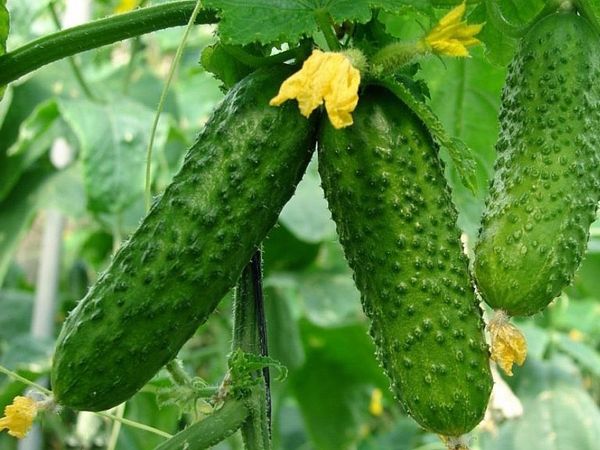Cucumbers are a popular vegetable in our country, so every gardener, regardless of the size of the plot, likes to grow cucumbers in his garden. But even with the same climatic features, the yield is different for everyone. The whole secret is in the care when growing cucumbers, planting must comply with the rules.
If you follow the proper agricultural practices, plant according to the advice on the predecessor crops and take care of them properly, then it will not be difficult for a beginner to get a good harvest even from seeds.
Table of contents
Basic requirements for growing cucumbers in open ground
In general, caring for a culture is not difficult, but given the climate of regional peculiarities, there are many nuances that need to be known.
The main requirements for growing cucumbers include:
- to plant are selected only healthy seeds that have been trained;
- the soil to sow must be loose and slightly acidic;
- planting seeds and seedlings is carried out in a strictly allotted time in compliance with the temperature regime;
- during the growing season is held 3-4 weeding and loosening ground;
- watering the beds with warm water is regularly carried out (10-14 liters per 1 m2);
- fertilizers and fertilizing are introduced according to the schedule, the norms of nutrient consumption can not be changed;
- beds should be located on the sunny sidebut not in a draft;
- when transplanting, avoid thickening;
- timely monitor the status of plants and the degree of soil moisture;
- when problems are identified, instantly process the culture.
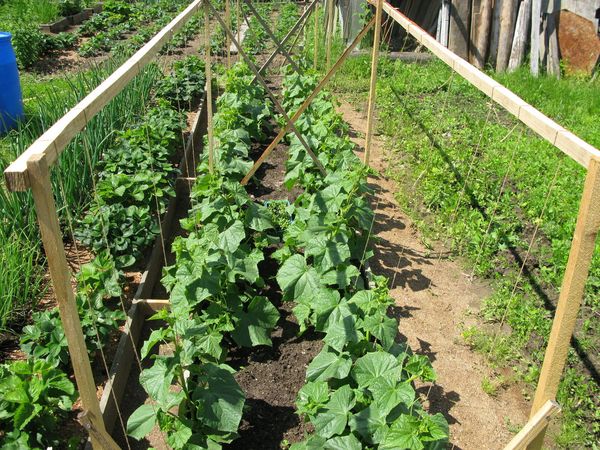
Growing methods
There are many options for growing greens. Among the most well-known ways: in the open field, greenhouse, on the balcony, in the barrel, etc.
How to plant seeds in the garden
To sow the seeds need at certain temperature indicators, otherwise shoots may not appear. The important point is soil and seed preparation. The quality of the work done depends not only on how they can germinate, but also on the intensity of the development of seedlings.
After the formation of 3-4 leaves, thin the bed often, leaving the strongest seedlings. At the stage of germination and shoot growth, it is important to ensure sufficient moisture, good illumination and fertilizer with any nutrientshelping the plant grow.
Seedlings
Seed method is used to obtain early harvest and in order to protect young shoots from spring frosts. Grown seedlings in the greenhouse or home conditions are transferred to the garden already strong.The root system of them, though weak, takes root quickly in the new environment.
Before planting sprouts in open ground must be adapted on the street, abrupt changes in habitat and temperature can destroy them.
Scourge can be spread out on the trellis. Depending on the method chosen, the spacing between bushes and rows should be kept. In the absence of a garter, the stalks should have enough space for laying on the bed.
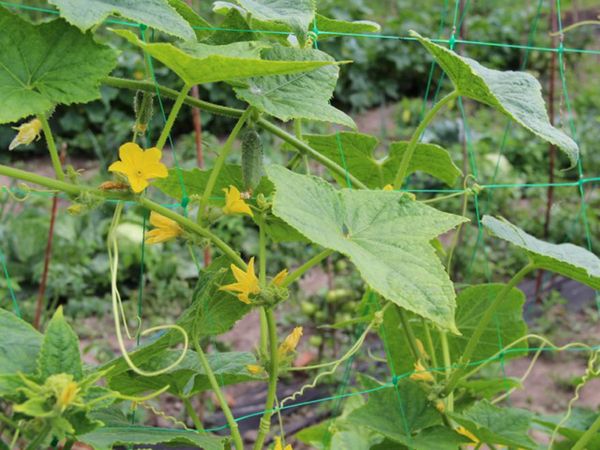
Where better to plant cucumbers to get a good harvest
The culture comes from India, so a hot, humid climate is ideal for it. The structure of the whip itself indicates the need for garters on the trellis.
The bed thus arranged is protected from fungal infections with an abundance of rain and from the scorching rays of the sun. Fruits find shade under the massive leaves of the plant. However, it is worth remembering that the scorching sun is also dangerous for cucumbers, burns can occur on the greenery.
Given the climatic features, you need to provide partial shading of the bushes or partial shade.This is easy to do by planting corn, sunflower or short grapes in the inter-row zone. Scattered light to the plant will be more useful.
With all the love of moisture you should not choose a plot in the valley for sowing cucumbers. With heavy rainfall and high groundwater levels, plants are threatened with fungal diseases due to overwetting. Much better place on the hill, where to control the degree of soil moisture is much easier.
Land preparation for planting
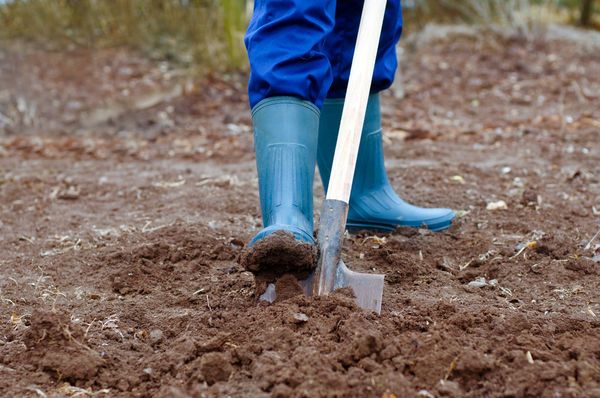
At the end of the season from the site all plant debris and trash are removed. For larvae of pests and other microorganisms, they are of great interest. In such an environment, parasites overwinter and by the spring already replenish colonies with a new generation.
To exclude this possibility, it is recommended to clean be sure to dig the ground (immersion depth not less than 25 cm). Make it better before the most frost, to prevent the parasites from finding a new refuge. Also, autumn work includes the introduction of fertilizers to increase the fertility of the soil.This process can be combined with digging.
In the spring plot dug up again and must be disinfected. To do this, use a weak solution of potassium permanganate or boiling water.
Cucumbers respond very well to this type of fertilizer as manure. It can be introduced both in the autumn and in the spring for 2-3 weeks before disembarking (8-10 kg per 1 m2). To stimulate the growth of young shoots, nitrogen and potassium phosphate substances (25 g of potassium salt, 40 g of superphosphate) are introduced into the soil.
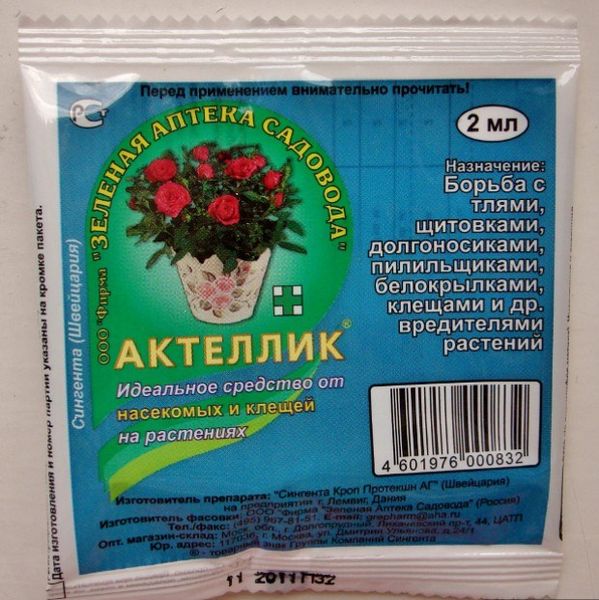
In the process of preparing the soil for the new season, in order to prevent the future bed of tree ash or special preparations that protect the bushes from pests (Fytoverm, Aktellik) should be treated.
How to plant in the soil
Growing green rice with seeds provides for compliance with the following rules:
- the sowing time is selected taking into account the favorable temperature conditions (end of May - beginning of June);
- seeds must be processed before planting;
- the soil should be decontaminated and fertilized;
- beds should be located east to west;
- landing pattern - 20x100 or 60x80 (depending on the method of cultivation);
- depth of immersion of seeds - 2-3 cm.
Rules for growing seedlings:
- seed must be trained (sorting, soaking, disinfection);
- soil is also necessary disinfect and enrich with nutrients;
- ideal for the cultivation of seedlings to use a substrate of turf land, mullein and humus (2: 1: 7);
- substances are applied for fertilizing the soil (30 g of ammonium nitrate or urea, 20 g of superphosphate, 6 g of potassium salt, 30 g of lime per bucket of soil);
- temperature regime after sowing - 12-15 degrees; after the seedlings managed to ascend at first several days, it is observed 20-25 degrees, then the temperature is reduced - during the day to 20-22 degrees, at night to 15 degrees;
- 10 days after the emergence of seedlings, the seedlings are fed with a slurry (1: 1) with the addition of 20 g of superphosphate to the mixture bucket;
- a week before the transfer of shoots in open ground daily spend hardening in fresh air;
- in order to prevent seedlings treated with epin or immunocytophyte.
Proper care of seedlings
Rules for the care of cucumber beds are very clear. Among the main conditions - creating a moist environment. This is governed by watering.
Ideal for use when sprouting sprinkling or drip irrigation. The use of a hose can damage the immature roots with a strong jet. A small area can be shed with a spray. The rate of water per 1 m2 is 10-14 liters.
Regularity of procedures - 1 time in 7 days with an average humidity of air 1 time in 5 days at temperatures above 28 degrees.
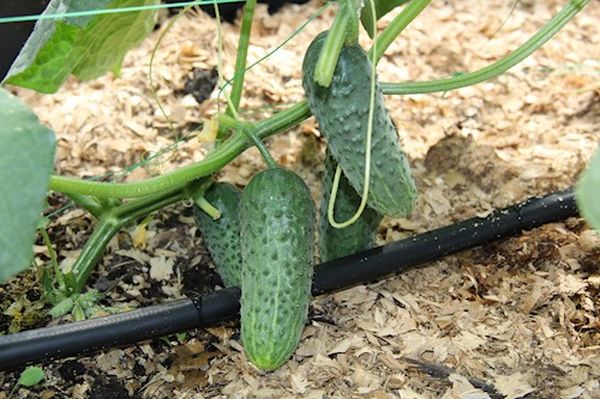
The intensity of development and the formation of a large lash requires a lot of power, so you can not ignore the mode of introduction of dressings. After the first sprouts appear on the soil surface, first dressing: 10 g of potassium salt, 10 g of ammonium nitrate, 30 g of superphosphate are taken for 10 liters of water.
Second feed The bed is enriched after 2 weeks, doubling the amount of dissolved fertilizers. When applying fertilizers, avoid contact of the working solution and the green part of the crop.
To protect cucumbers from rotting and pests, it is recommended to periodically weeding. This procedure is usually combined with loosening, which provides free access of oxygen to the soil and prevents the formation of stagnant moisture in the soil. The first weeding is done after forming 4-5 leaves on the shoots.
Spring weather is often unpredictable, so after sowing beds covered with film or agrofibre.
Based on the above information, it can be concluded that creating favorable conditions for the cultivation of cucumbers is easy. Timely prevention will prevent damage to the plant by pests and various diseases. And thanks to the lure and irrigation cucumbers will be endowed with high taste.
